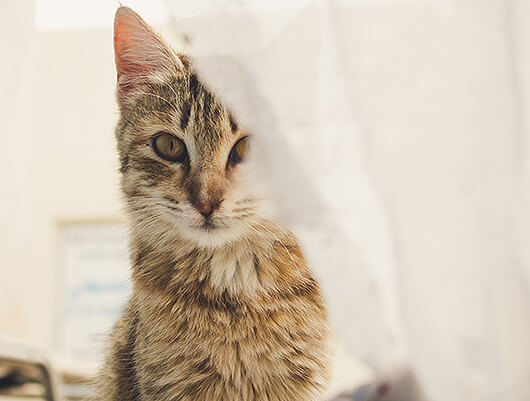
It’s a common belief that cats are highly susceptible to stress. How many memes have you seen referencing “neurotic kitty”? But the truth is, a cat’s normal state shouldn’t be stressed, she should be happy and relaxed! If our kitties are constantly showing signs of stress and anxiety, we owe it to them to identify solutions to help them feel better.
So how do you know if your cat is stressed versus just being naturally feisty? Well, the signs are subtle. Oftentimes, it’s a subtle change in behavior that doesn’t even seem to be related to anxiety. Some of the more common changes include …
- Urinating or defecating outside the litter box
- Isolating themselves from others in the household
- Excessive grooming
- Prolonged periods of sleep
- Excessive vocalization beyond what is typical (remember, some kitties are naturally more talkative than others)
- Increased scratching
- Aggression
Over time, stress hormones can contribute to physical symptoms such as diarrhea, constipation, changes in appetite or even the painful condition known as Feline Lower Urinary Tract Disease (FLUTD). Be aware that these signs are symptomatic of other medical conditions, so don’t be too quick to assume you’re dealing with feline anxiety before discussing the symptoms with your veterinarian. One of the best ways to minimize the likelihood of chronic medical conditions is to feed your cat a high quality, appropriate diet. Since you’re reading the Life’s Abundance blog, I’m probably preaching to the choir on that topic!

Let’s say your cat is exhibiting one or more of these signs of anxiety. You’ve brought her in for a check-up and medically, everything checks out. What next?
First, try to pinpoint the source of the stress and eliminate it, if possible. We tend to view these issues through our human lens, so it’s important to remember that unexpected things can be at the root of your cat’s stress. Some of the more obvious reasons include changes in living conditions – from divorce, moves, a new companion animal in the house, or new babies – to the most obvious physical cause, which is pain. But little changes can also provoke anxiety: new furniture, a neighbor’s dog barking, a dirty litter box, being denied access to their favorite location, a neighborhood tomcat taunting them from the yard, even music they don’t like! As you can see, it’s a long list.
Environmental modifications can make a big difference. For indoor cats, boredom can be a near-constant stressor, so provide lots of vertical space for exploration (they love being elevated). Home-built or store-bought cat trees are a great solution. Puzzle feeders can be a good source of environmental enrichment, as they appeal to their hunting instinct. Pheromone diffusers or sprays can also have a calming effect for some.

And lastly, make sure your kitty is getting daily interaction and enrichment with you. It’ll build their confidence and form deeper connections with their caregivers. Believe it or not, many behaviorists recommend clicker training as a great way to bond with your cat. This gives her a sense of control over her environment and also offers the promise of a yummy incentive like Gourmet Cat Treats for Healthy Skin & Coat. Cats can learn amazing tricks with clicker training and treats, but it’s also a great way to reward good behavior generally.
Try to set aside some one-on-one time for your cat in the space where she is most relaxed. Optimally, this is something you’ll do every day at the same time, because cats are true creatures of habit. No distractions, which means leave your phone in another room and turn off the TV. Brush, pet, sing … do whatever pleases your cat the most. It’ll be good for both of you!
A happy cat means a happy you! If you think your cat is suffering from stress or anxiety, try some of these suggestions to help them live the “purr-fect” life.
Thank you for all you do to make the world a better place for companion animals,
Dr. Jane Bicks